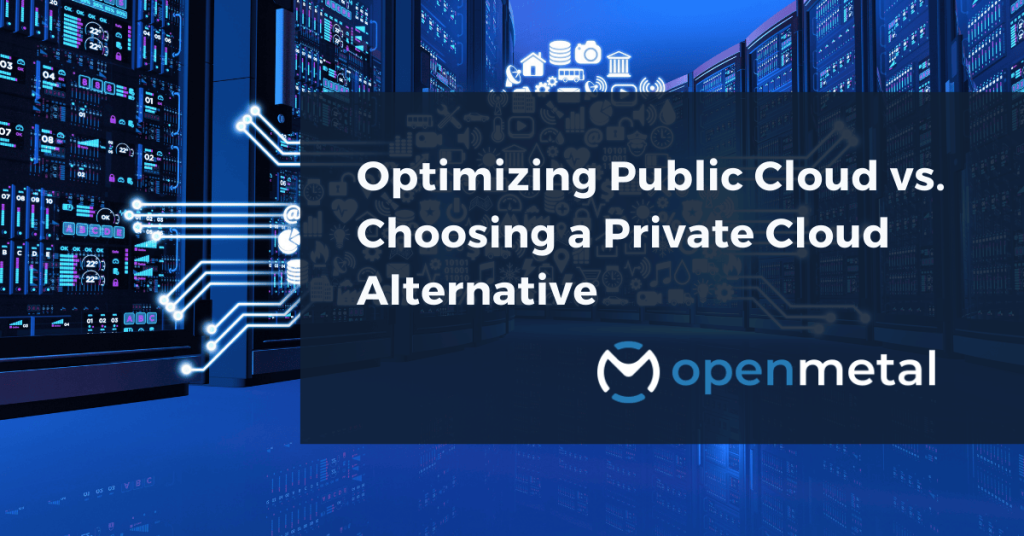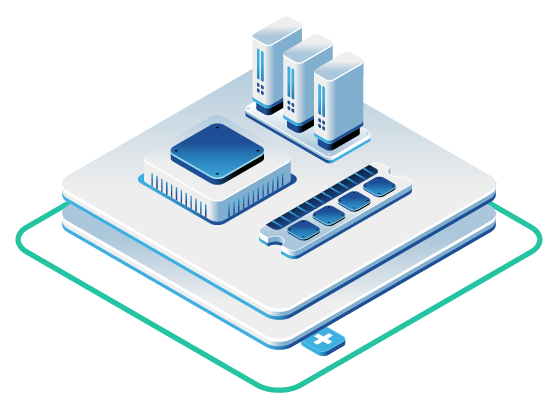
Tired of surprise cloud bills and unpredictable infrastructure costs?
The OpenMetal team is standing by to assist you with scoping out a fixed-cost model based infrastructure plan to fit your needs, budgets and timelines.
Your monthly cloud bill just hit $25,000 again—and you’re not even sure what’s driving the costs anymore. Sound familiar? If you’re like most CFOs and CTOs at growing organizations, you’re facing a familiar dilemma: should you double down on optimizing your existing public cloud setup, or is it time to explore private cloud alternatives that promise more predictable economics?
This isn’t just a technology decision—it’s a strategic business choice that impacts your organization’s financial predictability, operational flexibility, and long-term growth trajectory. Let’s examine both paths with the clarity you need to make an informed decision.
The Public Cloud Cost Reality Check
Public cloud promised simplicity: pay only for what you use, scale infinitely, and let someone else worry about infrastructure. But three major cost challenges have emerged that consistently frustrate finance and technology leaders:
Unpredictable Operating Expenses
Your cloud spending fluctuates month-to-month based on traffic patterns, development cycles, and sometimes mysterious usage spikes you can’t easily trace. This variability makes budgeting difficult and can create unwelcome surprises during board presentations.
Hidden and Compound Charges
Beyond compute and storage, you’re paying for data egress, API calls, premium support, advanced monitoring, and specialized services. These ancillary costs can represent 30-40% of your total bill, creating a complex web of charges that’s difficult to predict or control.
Over-Provisioning Tax
To avoid performance issues, teams routinely over-provision resources. You end up paying for capacity you don’t consistently need, but the alternative—undersized infrastructure affecting user experience—feels too risky.
Public Cloud Optimization: The Tactical Playbook
Before exploring alternatives, let’s acknowledge that significant savings are possible within public cloud environments. Here’s a structured approach to optimization:
Immediate Cost Controls
- Right-Sizing Resources: Use tools like AWS Cost Explorer or Azure Cost Management to identify oversized instances. Many organizations achieve 15-30% savings through systematic right-sizing.
- Reserved Instances and Savings Plans: Commit to baseline capacity with 1-3 year terms for 30-70% discounts on predictable workloads.
- Spot Instances: Leverage unused capacity for non-critical workloads at up to 90% discounts.
Governance and Visibility
- Comprehensive Tagging Strategy: Implement consistent resource tagging for cost allocation and chargeback models.
- Anomaly Detection: Set up automated alerts for unusual spending patterns using native cloud tools or third-party solutions like CloudHealth or Spot.io .
- Regular Cost Reviews: Establish monthly cross-functional reviews between finance and engineering teams.
Data and Storage Optimization
- Storage Tiering: Move infrequently accessed data to cheaper storage classes automatically.
- Data Locality: Minimize egress charges by keeping related services in the same region and availability zone.
- Archive Strategies: Implement lifecycle policies for long-term data retention at reduced costs.
These optimization strategies can deliver meaningful savings—often 20-40% of your current spend. However, they require ongoing management, specialized expertise, and constant vigilance as your infrastructure evolves.
The Private Cloud Alternative: Rethinking the Economics
While public cloud optimization focuses on managing complexity, private cloud takes a fundamentally different approach: eliminating complexity through predictable, dedicated infrastructure.
OpenMetal’s Hosted Private Cloud represents this alternative philosophy. Instead of optimizing around variable costs, you get flat subscription pricing with no surprise charges—including the complete elimination of egress fees that often inflate hyperscaler bills. Your infrastructure runs on dedicated hardware, ensuring consistent performance without the “noisy neighbor” problems that can affect public cloud workloads.
The deployment model addresses a critical pain point: speed to production. While traditional private cloud deployments can take months, OpenMetal clusters deploy in hours. You start with a hyperconverged Cloud Core of three nodes and scale seamlessly by adding nodes without downtime—giving you the agility benefits of cloud with the cost predictability of owned infrastructure.
The technical architecture integrates OpenStack with Ceph storage, providing unified object, block, and file storage within a single system. This eliminates the need to integrate multiple storage services and their associated costs. Enterprise-grade networking includes 20 Gbps NICs, VLAN and VXLAN segmentation, DDoS protection, and private networking as standard features rather than premium add-ons .
“We designed our pricing model to eliminate the financial friction that prevents organizations from fully utilizing their infrastructure,” explains Yuriy Shyyan, Director of Cloud Architecture at OpenMetal. “When IT teams don’t have to worry about every API call or data transfer generating costs, they can focus on building better applications and driving business value.”
Head-to-Head Comparison
| Factor | Optimized Public Cloud | OpenMetal Private Cloud |
|---|---|---|
| Monthly Predictability | Variable (±20-40% monthly) | Fixed subscription pricing |
| Egress Charges | $0.05-0.12 per GB | Included at no cost |
| Performance Consistency | Shared infrastructure | Dedicated bare metal |
| Scaling Model | Automatic but costly | Manual but predictable |
| Operational Overhead | Continuous optimization required | Set-and-forget infrastructure |
| Compliance Readiness | Extra configuration needed | HIPAA, SOC 2, ISO aligned |
| Time to Deploy | Immediate | Hours (vs months traditional) |
| Lock-in Risk | High (proprietary services) | Lower (open standards) |
CFO vs. CTO Perspectives: Different Priorities, Aligned Interests
The CFO Viewpoint: Financial Predictability
CFOs value budget certainty and operational expense control. Public cloud’s variable pricing model creates forecasting challenges, especially during growth phases when usage patterns change rapidly. The appeal of private cloud lies in converting variable operating expenses into predictable monthly costs, making financial planning more straightforward.
However, CFOs also consider opportunity costs. The upfront effort and resources required to transition infrastructure must be weighed against ongoing optimization efforts and the risk of continued cost escalation in public cloud.
The CTO Viewpoint: Technical Control and Performance
CTOs focus on performance consistency, technical flexibility, and team productivity. Public cloud offers extensive services but can create dependency on proprietary platforms. Private cloud provides more control over the technology stack while ensuring predictable performance for critical workloads.
The technical team’s time is another consideration. Continuous public cloud optimization requires specialized expertise and ongoing attention. Private cloud shifts this effort from continuous optimization to initial setup and periodic scaling decisions.
Decision Framework: When to Optimize vs. When to Shift
Optimize Public Cloud When:
- Your monthly spend is under $10,000 consistently
- Workloads are highly variable and unpredictable
- You need extensive managed services and don’t want to manage infrastructure
- Your team has strong cloud optimization expertise
- Compliance requirements are minimal
Consider Private Cloud When:
- Monthly cloud spending consistently exceeds $10,000
- Workloads are steady and predictable
- Egress charges represent a significant portion of your bill
- Performance consistency is critical for user experience
- You want to eliminate the ongoing overhead of cost optimization
- Compliance requirements are substantial
The Hybrid Reality
Many organizations don’t need to choose exclusively. You might run steady, predictable workloads on private infrastructure while using public cloud for variable capacity, development environments, or specialized managed services.
Why OpenMetal Fits This Strategic Shift
OpenMetal specifically designed their platform for organizations making this transition. The flat subscription pricing model eliminates the variable cost problem that drives many optimization efforts. By including egress, networking, and storage in the base price, you get cost predictability that’s difficult to achieve in public cloud environments.
The platform’s focus on dedicated hardware addresses performance concerns while maintaining cloud-like agility through rapid deployment and seamless scaling. For organizations consistently spending over $10,000 monthly on cloud infrastructure, this model often delivers both cost savings and operational simplification. The cost savings are even more substantial at scale.
The compliance-ready architecture (HIPAA, SOC 2, ISO frameworks) reduces the additional configuration and cost often required to meet regulatory requirements in public cloud environments.
Reframing the Decision: Control vs. Complexity
The choice between optimizing public cloud and shifting to private alternatives isn’t just about cost—it’s about how you want to allocate your organization’s attention and resources.
Public cloud optimization requires ongoing investment in expertise, tools, and management processes. You’re essentially accepting complexity in exchange for flexibility and managed services. This approach works well for organizations with strong DevOps capabilities and highly variable workloads.
Private cloud shifts complexity to the infrastructure provider and gives you predictable costs and performance. You trade some flexibility for control and operational simplicity. This approach aligns well with organizations that have steady workloads and want to focus their technical teams on application development rather than infrastructure optimization.
Neither path is inherently superior—the right choice depends on your organization’s workload patterns, technical capabilities, and strategic priorities. However, if you’re spending significant time and resources on cloud cost optimization while still facing unpredictable bills, it may be time to seriously evaluate whether a different infrastructure model better serves your business objectives.
The key insight is that this decision isn’t permanent. Many successful organizations use hybrid approaches, running predictable workloads on private infrastructure while leveraging public cloud for variable capacity and specialized services . The goal is matching your infrastructure choices to your business requirements rather than forcing your business to adapt to infrastructure constraints.
Want to learn more about OpenMetal’s hosted private cloud?
Explore how OpenMetal can help with a PoC Cloud
Start with a risk-free evaluation: Take advantage of OpenMetal’s Proof of Concept program to validate how hosted private cloud can transform your delivery model.
Works Cited
- Andreessen Horowitz. “The Cost of Cloud, a Trillion Dollar Paradox.” Andreessen Horowitz, 2023, a16z.com/the-cost-of-cloud-a-trillion-dollar-paradox/.
CloudZero. “90+ Cloud Computing Statistics: A 2025 Market Snapshot.” CloudZero Blog, 2025, www.cloudzero.com/blog/cloud-computing-statistics/.
Flexera. “2024 State of the Cloud.” Flexera, 2024, www.flexera.com/stateofthecloud.
Flexera. “State of the Cloud Report.” Flexera, info.flexera.com/CM-REPORT-State-of-the-Cloud.
Spacelift. “How to Migrate from Terraform Cloud to Spacelift.” Spacelift Blog, spacelift.io/blog/how-to-migrate-from-terraform-cloud.







































